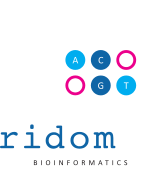Whole genome based Mycobacterium tuberculosis surveillance: A standardized, portable, and expandable approach
A new study published in Journal Clinical Microbiology demonstrated that standardization of whole genome sequencing based (WGS) genotyping of the bacteria causing tuberculosis (TB) is possible, and can be used for improved tracing of pathogen transmission.
Genotyping of Mycobacterium tuberculosis (Mtb) is indispensable for understanding recent transmission dynamics to guide tuberculosis control strategies efficiently. This is of particular relevance as multidrug (MDR) and extensively drug resistant (XDR) strains have emerged. Recent papers revealed that whole genome sequencing (WGS) based molecular typing is an optimal tool to trace outbreaks accurately. However, it is difficult to standardize and not yet used for surveillance.
In the current study, a team of experts from Ridom, public-health institution, research institute and Universities in Germany led by Stefan Niemann from the Forschungszentrum Borstel developed a so called core genome multi locus sequence typing (cgMLST/MLST+) scheme for clinical Mtb isolates that transfers the genome wide sequence diversity (mainly single nucleotide polymorphism [SNPs]) into an allele numbering system that is standardized, portable and not computational intensive. By analyzing 26 isolates from a longitudinal outbreak in the federal state of Hamburg, Germany (notified between 2001 and 2010) they found that the cgMLST/MLST+ approach (3,041 genes) discriminated the 26 strains with a resolution comparable to SNP based WGS typing, and much better than classical genotyping that interrogates small parts of the genome only.
"We and others have already demonstrated that genome based investigations are superior compared to classical genotyping methods for tracing pathogen transmission. Now we have for the first time the tools to standardize this approach and use it for longitudinal epidemiological investigations locally and globally." said Dr. Stefan Niemann, last author of the study.
The main advantage of the cgMLST/MLST+ approach is that it generates easy to compute numerical "strain types" that can be used for expandable database, e.g. for local studies but also for investigation of the global spread of particular strains types, e.g. highly transmissible MDR/XDR strain variants.
"We are really excited about the results of this cooperation as it paves they way for a low-compute, low-bandwidth, portable and scalable approach that will help us to standardize WGS surveillance on a global level" commented Dag Harmsen from the University of Münster, co-author of the study.
Importantly, as Next Generation Sequencing costs for whole genome based analysis are constantly declining, this approach could soon become the standard method for identifying transmission patterns and rates of infectious disease outbreaks.
The major obstacle for the general use of Next Generation Sequencing WGS analysis is a standardized global nomenclature system. "In a joint effort with partners from several European countries we are further developing the cgMLST/MLST+ system to open the door for a wide application of WGS for global outbreak detection and infectious disease surveillance" explained Dr. Niemann.
Citation
Kohl TA, Diel R, Harmsen D, Rothgänger J, Meywald Walter K, Merker M, Weniger T, Niemann S (2014) Whole genome based Mycobacterium tuberculosis surveillance: a standardized, portable and expandable approach.
J. Clin.Microbiol. JCM.00567-14; published ahead of print 30 April 2014, doi:10.1128/JCM.00567-14


